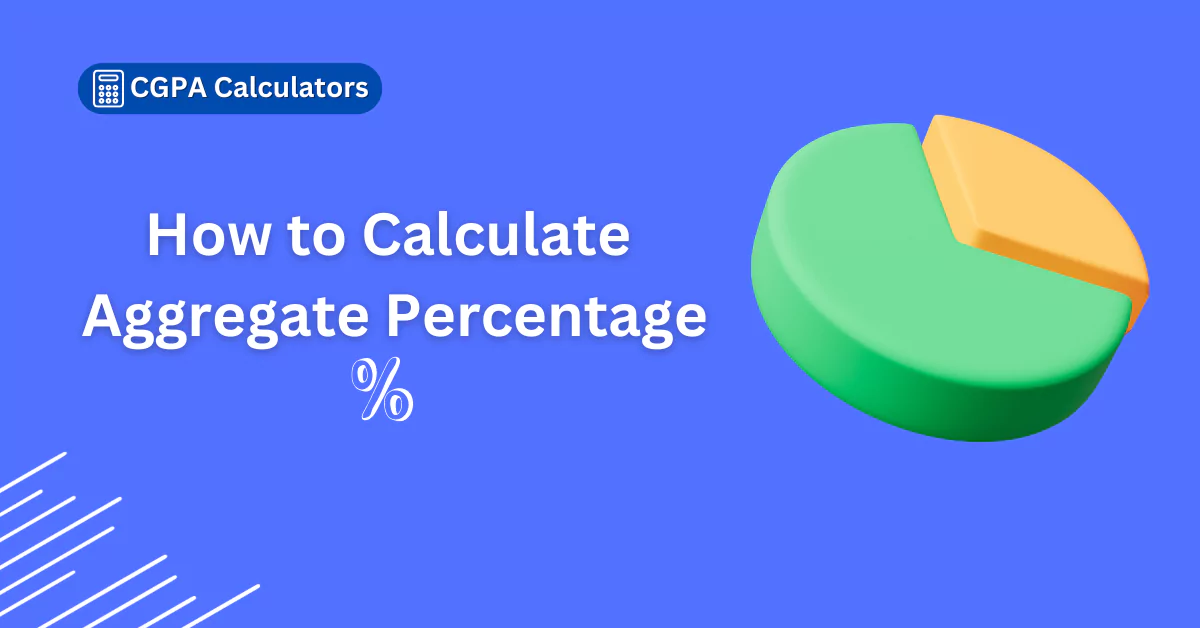How to Calculate Aggregate Percentage
Aggregate Percentage Calculator
Calculate your weighted aggregate percentage with visual insights
Subjects
Calculating the aggregate percentage is critical for understanding your academic performance as part of college admissions, scholarships, and job applications.
Although calculating this statistic may seem intimidating at first, this guide will make the process easy for you.
What is Aggregate Percentage?
An aggregate percentage is the combined average of percentages from multiple subjects or semesters.
It provides a comprehensive snapshot of your performance over a particular period.
Unlike individual subject percentages, the aggregate percentage includes all your scores, giving you a more holistic view of your academic achievements.
Some universities provide tools to convert your GPA to percentage for more accurate grade comparisons.
Why is Aggregate Percentage Important?
- College Admissions: Many colleges and universities require your aggregate percentage for admission.
- Scholarships: A higher aggregate percentage can improve your chances of securing scholarships.
- Job Applications: Some employers look at your aggregate percentage to gauge your academic consistency.
Steps to Calculate Aggregate Percentage
Follow these steps to calculate your aggregate percentage accurately:
Step 1: Gather Your Scores
Collect all your subject scores or semester percentages that you need to include in the aggregate calculation.
Step 2: Convert Scores to Percentage (if needed)
If your scores are not already in percentage form, convert them. For instance, if you have grades, you’ll need to convert those to percentages based on your institution’s grading scale.
Example:
If the maximum marks for a subject are 100, and you scored 85, your percentage for that subject is:
Percentage = (Marks Obtained / Total Marks) * 100
Percentage = (85 / 100) * 100 = 85%
Step 3: Sum up All the Percentages
Add all the percentages from the subjects or semesters you include in the aggregate calculation.
Example:
If your percentages are 85%, 90%, 78%, and 88%, then:
Sum of Percentages = 85 + 90 + 78 + 88 = 341
Step 4: Count the Number of Subjects or Semesters
Determine how many subjects or semesters are included in your calculation.
Example:
In the above example, there are 4 subjects.
Step 5: Calculate the Aggregate Percentage
Divide the sum of the percentages by the number of subjects or semesters and multiply by 100 to get the aggregate percentage.
Example:
Aggregate Percentage = (Sum of Percentages / Number of Subjects or Semesters)
Aggregate Percentage = (341 / 4) = 85.25%
Practical Example
Let’s go through a practical example to further clarify the process.
Scenario
You have the following percentages for four semesters:
- Semester 1: 84%
- Semester 2: 76%
- Semester 3: 89%
- Semester 4: 91%
Calculation
- The sum of Percentages:
84 + 76 + 89 + 91 = 340
- Number of Semesters:
4
- Aggregate Percentage:
340 divided by 4 equals 85 percent
Therefore, your aggregate percentage is 85%.
You can check out the CGPA to Percentage Calculator if you get a CGPA instead of a percentage in your academics.
Average of Percentages Calculator
Many of you might be confused between aggregate percentage and average percentage.
When the combined scores from multiple subjects or semesters or exams are divided by no of subjects or semesters or exams and make one final percentage that is the aggregate percentage.
On the other hand, when the average score is divided by the total (highest) possible score and the final result is multiplied by 100, it defines the average of percentage.
This gives you an idea of the difference between aggregate percentage and average percentage.
Tips for Accurate Calculation
- Double-check your scores: Ensure all scores are correctly noted before calculating.
- Use a calculator: It helps in avoiding manual errors.
- Understand the grading system: Different institutions may have different grading scales.
Common Challenges and Solutions
Missing Scores
If you are missing scores for any subject or semester, try to obtain those before calculating. If unavailable, you might have to adjust your calculation based on the available scores.
Conversion Confusion
If you’re unsure how to convert grades into percentages, consult your institution’s guidelines or speak with a teacher.
Multiple Grading Systems
In cases where different subjects use different grading systems, ensure you convert all scores to a common scale before calculating the aggregate percentage.
An aggregate percentage calculator helps students quickly determine their overall academic score from multiple semesters.
If you want to know how to calculate GPA from percentage, the process is almost similar, but it uses a different formula and scale.
Frequently Asked Questions (FAQ)
1. What if my institution uses a GPA system instead of percentages?
If your institution provides grades in GPA, you will need to convert your GPA to percentages based on your institution’s conversion scale. For example, if a 4.0 GPA is equivalent to 100%, a 3.5 GPA might be equivalent to 87.5%. Always refer to your specific institution’s conversion guidelines.
2. Can I include extracurricular activities in my aggregate percentage?
No, the aggregate percentage calculation only includes academic scores. Extracurricular achievements are important but are typically considered separately in college admissions, scholarships, and job applications.
3. What should I do if there are discrepancies in my scores?
Double-check your marks with official documentation such as report cards or transcripts. If discrepancies persist, consult your institution’s administrative department to rectify them before calculating your aggregate percentage.
4. How do I handle subjects with different maximum marks?
Convert each subject’s score to a percentage individually, regardless of the maximum marks, before summing them up. This ensures uniformity across varying grading criteria.
5. Is there a difference between aggregate percentage and cumulative GPA?
Yes, the aggregate percentage is a simple average of percentage scores across subjects or semesters. A cumulative GPA is a weighted average and may account for the credit hours of different courses. Always clarify which metric is required by the institution or employer.
6. Can I use online calculators for aggregate percentage?
Yes, many reliable online tools are available to calculate aggregate percentages. However, ensure you manually verify the results to avoid any computational errors.
7. Why are my aggregate percentage and my percentile rank different?
The aggregate percentage is a direct average of your scores, while the percentile rank compares your performance to others. Percentiles indicate the percentage of peers you have outperformed and thus can differ from your aggregate percentage.
Conclusion
Calculating your aggregate percentage is an effortless, essential task in both academic and professional environments.
Simply by following these steps — gathering scores, converting them to percentages when necessary, totaling them, and then dividing by the total number of subjects or semesters studied — you can accurately ascertain your academic performance.
This metric not only aids job applications and further studies, but it can also track your academic progress comprehensively.
Students also got stuck while calculating percentage increase in academics.
When entering data, always ensure its accuracy is not falsified to avoid making errors; being diligent throughout this process can significantly enhance your academic portfolio while giving a true indication of where you stand in terms of academics.







